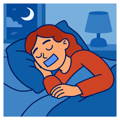Lip - Mouth Taping Isn’t Enough: Why True Myofunctional Breathing Needs Muscle Support Too (Ottawa 2025)
“Lip taping may prompt nasal airflow, but only functional muscle training creates lasting airway tone and true breathing correction.”
— Stanford Sleep Medicine Center
"Targeted tongue and airway exercises significantly improve airway stability, reduce apnea events, and complement other sleep therapies without surgery or medication."
— Mayo Clinic
Audience: Adults using or considering mouth tape for snoring or sleep apnea, parents exploring natural sleep solutions, wellness practitioners, airway-conscious dentists
Read time: 5 minutes
Key takeaway: While mouth taping may encourage nasal breathing, it doesn’t retrain the muscles that control your airway. Orofacial Myofunctional Therapy builds proper muscle tone and function—helping you breathe better, sleep deeper, and reduce symptoms long term.
You’ve Heard of Mouth Taping—But Is It Enough?
If you've searched for natural snoring remedies lately, chances are you've seen mouth taping everywhere. Social media wellness circles, biohacking podcasts, and even mainstream sleep influencers are raving about it.
But while taping your lips closed might seem like a quick fix for mouth breathing, it doesn’t address the real reason you're doing it in the first place...
What Is Mouth Taping?
Mouth taping involves applying skin-safe tape across your lips before bed to encourage nasal breathing overnight. The idea is simple—keep the lips closed, and airflow is forced through the nose.

Some people report benefits like:
- Reduced snoring
- Improved sleep quality
- Waking up with a moist - not dry mouth

But many also experience:
- Anxiety or panic during sleep
- Nasal congestion
- Continued snoring
- Tape falling off
- No long-term change once the tape is removed
Why? Because taping the lips doesn’t retrain the muscles that keep your mouth closed, your tongue lifted, and your airway toned.
Functional Breathing Needs Functional Muscles
Your lips, tongue, jaw, and soft palate all play a role in keeping your airway stable—especially at night. If these muscles are weak or uncoordinated, the mouth tends to fall open during sleep. That’s why the effect of taping is often temporary.
Myofunctional therapy is like a muscle coach for your airway. It retrains:
- Lip seal strength
- Tongue posture and tone
- Soft palate elevation
- Nasal breathing habits
- Jaw muscle tone and posture
- Dynamically opens the airway
- Increases Oxygen intake
Unlike mouth taping alone, myofunctional therapy helps build lasting muscle memory. This leads to better sleep quality, reduced snoring, and improved CPAP tolerance when needed. Our customized programs retrain your breathing patterns at the root—step by step, with no guesswork or one-size-fits-all plans.
5 Signs Mouth Taping Might Not Be Enough
- You still wake up tired—even after 7 hours of sleep
- You are experiencing brain fog or memory difficulties
- Your jaw aches in the morning or pops during the day
- You breathe through your mouth during the day
- You rely on nasal sprays to breathe through your nose
- The tape doesn’t stay on—or feels stressful
Just because mouth taping isn’t fixing everything doesn’t mean it’s useless. It can still help—but without retraining the muscles, deeper breathing issues often persist.
Case snapshot
Patient: Ottawa woman, age 35
Concern: Daily fatigue, loud snoring, tried mouth taping for 3 months with minimal improvement
Approach: Completed 6 months of myofunctional therapy at Oral-Facial Advantage
Outcome: Transitioned to full nasal breathing, snoring eliminated, energy levels improved significantly
Quote: “The tape helped me notice the issue. Therapy helped me fix it.”
Ready to Breathe Better—Naturally?
If you’ve tried mouth tape, but you’re still tired, congested, or snoring… it’s time to go deeper.
At Oral-Facial Advantage in Ottawa, we help you uncover and treat the root cause behind your mouth breathing, fatigue, and disrupted sleep.
The Process of Orofacial Myofunctional Therapy
We perform a 360º Orofacial Myofunctional Therapy 2 hour assessment at our Ottawa clinic to pinpoint each patient’s unique mix of factors.
Initial Assessment
A detailed consultation to evaluate airway function, oral posture, and breathing patterns.
Customized Exercise Plan
A simple, daily set of exercises designed specifically for your sleep-breathing needs.
Regular Progress Reviews
Brief check-ins to monitor improvement, adjust exercises, and ensure effectiveness.
Collaboration with Healthcare Providers
Regular communication with your sleep physician, dentist, or ENT to coordinate your overall care plan.
Book a free 45‑minute consultation (in‑person or virtual) to learn if myofunctional therapy is right for you.
Frequently Asked Questions
Q: Why isn’t mouth taping alone enough to fix snoring or sleep apnea?
A: Mouth taping may encourage nasal breathing temporarily, but without proper muscle tone in the tongue, lips, and airway, the effects are often short-lived. Myofunctional therapy addresses the root cause.
Q: Can myofunctional therapy help if I already use mouth tape at night?
A: Yes. Therapy strengthens the muscles that keep your airway open and your lips sealed naturally—making mouth tape more effective or even unnecessary over time.
Q: What’s the difference between mouth taping and functional breathing training?
A: Mouth taping is a passive external aid. Functional breathing training teaches your body to maintain nasal breathing and airway tone all day and night, even without external tools. The taping is part of a process. not to entire process.
🧠 References
Stanford Medicine Sleep Center.
The Role of Orofacial Myofunctional Therapy in the Treatment of Sleep-Disordered Breathing.
Stanford University, Department of Otolaryngology – Sleep Surgery Program.
Camacho, M., Certal, V., et al. (2015).
Myofunctional therapy to treat obstructive sleep apnea: a systematic review and meta-analysis.
Sleep, 38(5), 669–675.
Pacheco, M., et al. (2022).
Effects of Orofacial Myofunctional Therapy on Snoring and Apnea Severity in Adults.
Journal of Clinical Sleep Medicine, 18(2), 399–406.
Guilleminault, C., Huang, Y.S., Monteyrol, P.J., et al. (2013).
Critical role of myofascial re-education in pediatric sleep-disordered breathing.
Sleep Medicine, 14(6), 518–525.
Branco, A., et al. (2020).
Mouth breathing and its consequences in pediatric patients: A review.
Brazilian Journal of Otorhinolaryngology, 86(5), 580–590.



